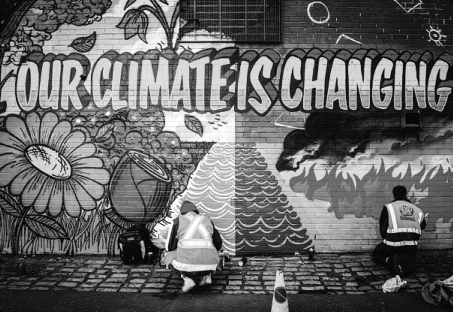Action taken as climate and biodiversity threats mount
Extreme weather events and natural disasters take their toll in past year

Threats from climate change and to biodiversity appeared to be overshadowed last year as the COVID-19 pandemic raged around the world, along with regional conflicts and political differences.
Although not every natural disaster or extreme weather event is caused by or related to climate change, more evidence emerged of a strong connection.
In August, the United Nations Intergovernmental Panel on Climate Change published the first part of its sixth assessment report, which stated that evidence of human influence has strengthened in relation to hurricanes and tropical cyclones.
According to the report, the number of intense tropical cyclones, average wind speeds of peak tropical cyclones, and peak wind speeds for the most intense cyclones will rise worldwide due to increased global warming.
Also in August, the deadly and destructive Hurricane Ida swept the United States, the second-most-damaging and intense hurricane on record to make landfall in the state of Louisiana after Hurricane Katrina in 2005. Ida headed north and caused extensive flooding in New York City and the surrounding area.
The National Centers for Environmental Information, or NCEI, said the hurricane caused damage estimated at least $75.25 billion, the costliest disaster in the US and worldwide last year.
According to reinsurance company Munich Re's annual report, economic losses from natural disasters globally last year reached $280 billion, the fourth-highest total after 2011, when a massive earthquake and tsunami struck Japan.
Floods, storms and drought also displaced millions of people across the world, and the report said nearly 10,000 died as a result of natural disasters last year, comparable to such death tolls in recent years. The company warned that studies showed a link between global warming and natural disasters.
Widespread flooding in Europe took the second-highest financial toll after Hurricane Ida last year.
In July, a dozen European countries experienced severe flooding, with deaths and widespread damage reported in some nations. Germany was the most badly hit, with nearly 200 people losing their lives.
Malu Dreyer, governor of Rhineland-Palatinate state in southwest Germany, one of the worst-affected areas, said: "Climate change isn't abstract anymore. We are experiencing it up close and painfully."
In Africa, weeks of heavy rains in South Sudan since July claimed roads, homes and inundated farmland, with more than 850,000 people affected. The flooding in some parts of the country is the worst for 60 years.
Arafat Jamal, the UN High Commissioner for Refugees representative in South Sudan, said: "The country is on the front line of the climate emergency, in which people are the collateral damage of a battle they did not pick."
In May, Cyclone Yaas struck India and Bangladesh, causing damage estimated at $3 billion in just a few days and forcing the evacuation of more than 1.2 million people in low-lying areas, according to the Christian Aid charity organization, which is based in the United Kingdom.
At the end of last year, heavy flooding hit northeast Brazil, killing dozens of people and injuring more than 200. Tens of thousands of residents had to leave their homes.
Cold snap, heat wave
High temperatures and snow were also part of the climate change story in 2021.
In February last year, a cold snap and winter storm hit many northwest, central and eastern states in the US, causing damage put at $24 billion.
Texas and other southern states experienced widespread power outages, with temperatures below freezing recorded for many days. At the peak of the outages, nearly 10 million people were without power, according to the NCEI.
Europe and the Middle East experienced heavy snowfall, which blanketed the Acropolis and other ancient landmarks in Athens, the Greek capital, and halted many public services in Libya, Lebanon, Jordan, Syria, Saudi Arabia and Israel.
Will Steffen, a spokesman for the Climate Council in Australia and an expert on climate change, said cold air is usually held in check by the jet stream-a narrow variable band of extremely strong predominantly westerly air currents encircling the globe at an altitude of several kilometers.
However, the so-called gradient between the equator and North Pole is now weakening, with cold air breaking through as warm air is dragged up, Steffen said.
According to the European Union's Copernicus Climate Change Service, satellite measurements showed that last year was one of the warmest on record, with the annual average temperature 1.1 C to 1.2 C higher than during the preindustrial period from 1850 to 1900.
In summer, a vast area of the western US and Canada experienced a heat wave on a scale thought to occur only once in 1,000 years.
In the US, a temperature of 46.7 C was recorded in Portland, Oregon state, while a high of 42.2 C was reported in Seattle, Washington state. In Canada, the mercury rose far above 30 C in Vancouver, where summer temperatures average about 20 C.
The extreme temperatures caused hundreds of direct and indirect heat-related fatalities and also triggered wildfires and droughts in the two neighbors, severely threatening humans and wildlife.
In October, the UN's COP 15 Biodiversity Conference, held in Kunming, Yunnan province, made clear that the world is experiencing species loss at an alarmingly high rate and that ecosystem collapse will spell disaster for humans and the planet. As a result, urgent action must be taken.
The gathering aimed to set a global framework for biodiversity post-2020 and to give biodiversity the same level of protection as the climate.
Zhang Jun, China's permanent representative to the UN, said:"Climate change and biodiversity loss have sounded the alarm for humankind and forced us to think deeply about the relationship between man and nature."
The Kunming Declaration was adopted on Oct 13, committing parties to the convention to ensuring the development, adoption and implementation of an effective post-2020 global framework to reverse biodiversity loss and ensure that biodiversity is put on the road to recovery by 2030 at the latest.
Elizabeth Maruma Mrema, executive secretary of the UN Convention on Biological Diversity, said:"With the conclusion of the first part of COP 15, we have taken a critical step toward writing a new chapter for our planet and for our societies.
"Adoption of the Kunming Declaration, and the strong political direction provided by many ministers, has put us firmly on the path to the adoption of an effective post-2020 global biodiversity framework that will engage the entire world in the task of putting nature on a path to recovery by 2030."
The declaration also noted calls made by many countries to protect and conserve, by 2030, some 30 percent of the world's land and sea areas through well-connected systems of protected zones and other effective area-based conservation measures.
At the gathering, the Kunming Biodiversity Fund was established to support biodiversity protection in developing countries, with China taking the lead by investing 1.5 billion yuan ($233 million).
Progress witnessed
In Qinzhou, Guangxi Zhuang autonomous region, in November, 18 years after almost being killed by a fishing net, a Chinese white dolphin gave birth to her third cub.
The birth was encouraging news for a team of scientists stationed in the area for decades, as the newborn offered further proof that economic development and biodiversity conservation are not mutually exclusive.
In Qinzhou, a road separates the dolphin habitat from an area reserved for port construction work and economic development, ensuring the mammals are not disturbed. The rising number of white dolphins in the area has also attracted a large number of other aquatic species, benefiting local fishermen.
Meanwhile, in the Chinese capital, members of a scientific team have started a project with Liu Zhiqing, an artificial intelligence expert from Beijing University of Posts and Telecommunications. The two sides are exploring AI's potential for contributing to this conservation work.
Zhao Yu, a member of the team, said:"We are discussing how to use AI to help scientists classify photographs of individual white dolphins through image recognition. Once applied, the project can greatly improve the accuracy of recognition and save scientists more time and energy for other research."
Liu and Zhao both expect the project to contribute to conservation work for more species.
Ahead of the COP 26 UN Climate Change Conference, held in autumn in Glasgow, Scotland, three key players wrote: "The science is clear: climate, biodiversity and human health are fully interdependent."
This view was expressed by Frans Timmermans, the European Commission vice-president who heads the European Green Deal, Achim Steiner of the UN Development Programme, and Sandrine Dixson-Decleve from the Club of Rome think tank.
After several rounds of debates and arguments, the 197 participating countries adopted the Glasgow Climate Pact at the end of COP 26, marking a degree of historic and encouraging progress.
They reached a consensus on the need to come up with increased targets and action to prevent planetary warming exceeding preindustrial levels by 1.5 C.
The participants also reached consensus on Article 6 of the Paris Agreement, which relates to carbon market mechanisms, paving the way for effective implementation of the Paris deal to cut emissions through market-based approaches.
During the final days of the gathering, China and the US, which differ over many topics, agreed to work together to tackle this global topic, with the two countries issuing a joint declaration on enhancing climate change action throughout this decade.
Xie Zhenhua, China's special climate envoy, said global warming is increasingly urgent and severe, and the two nations should shoulder international responsibilities and obligations.
John Kerry, his US counterpart, said cooperation is "the only way to get things done".
"We cannot reach our goals without countries working together, and China and the US, in particular, as the two largest emitters in the world, both have to help show the way," Kerry said.



Today's Top News
- Poll findings indicate Taiwan people's 'strong dissatisfaction' with DPP authorities
- Xi emphasizes strong start for 15th Five-Year Plan period
- PLA drills a stern warning to 'Taiwan independence' separatist forces, external interference: spokesperson
- Xi, Putin exchange New Year greetings
- ROK leader's visit to help boost bilateral ties
- China's new plan, world's new opportunities






























